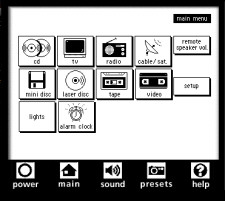 |


TechnoFILE is copyright and a registered trademark © ® of
Pandemonium Productions.
All rights reserved.
E-mail us Here!

Remote Intelligence?Learning, Schmearning - why can't someone make a real smart remote control? A plea for logic and user-friendliness in remotes Commentary by Les Enser In my many years of being an audio and videophile, I have had my share of remote controls - for just about every piece of equipment I have ever collected. My coffee table at times seems to disappear amongst the refuse of remotes and, although I certainly enjoy the convenience, I often wish the electronic manufacturers could find a better way. Oh, sure we have the "smart or learning remotes" but unfortunately they don't always solve the problem. There are times I need a certain function at my disposal that the smart remote has no memory for. A good example of this was when I had recently misplaced my Laser Disc remote and I had a good friend over for an afternoon to view a few classic movie clips to show off my surround system. It was so frustrating to manually find the chapter stops that it took away the enjoyment and the flow of the demonstration. I was using my learning remote but it only knew the basic functions of the Laser player. Suppose you lost your VCR remote and couldn't program your favourite sitcom! Smart remote to the rescue? Highly unlikely. Fortunately, some of the manufacturers have some interesting alternatives - such as Lexicon whose remote features a graphical user interface (GUI) which mimics the remote control function of your component. This means that the actual controls are recreated graphically, on a backlit LCD display! However its $2500 cost is not exactly pocket change for some. Recently Kenwood's new Stage 3 series introduced the KC-Z1, what seems to be a radically innovative design in A/V preamp/processor technology. It features a detachable LCD touch screen remote. The unit, measuring about 4.9 X 6.8 X 2 inches, uses RF (radio frequency) technology, which allows the user to operate the preamp from any where in the house! The remote uses icons and graphics to help you set up everything from the basic functions to more complex surround parameters. The remote is configured in a "layered progressive menu" configuration, taking your from the simple to the more in depth settings. Cost of the preamp about $3900. Sony also has a remote that doesn't get much exposure but is worth looking at. It's the RMV1100 which, at least in Canada, is available only as a special "parts department" order item. It used to be included with the old KV32XBR90S TV monitor. The remote is backlit and features control menus for whatever piece of hardware you're using. As an example, if you press the LD (laser disc) function, those controls appear on the LCD screen. The touch sensitive screen is ideal and appears to solve the "lost" remote scenario. Also, with the backlit function, it's much easier to see what you're doing in a dimly lit room. I do wish that the actual function select buttons (i.e. TV, VCR, Amp, Tape, etc.) were also lit up, but I guess you just can't have everything. Do bear in mind this unit is quite wide and may not fit comfortably in all hands; also it takes 6 AA batteries and can go through them rather quickly when you use this as your only remote. The price, you ask ? Around $375. Yamaha has some remotes that feature a bright yellow layout, which is better - but it still can't beat a lighted remote. It would even be nice if, when you bought that high end Home Theatre receiver or preamp, it would include a decent, legible, backlit learning remote like Kenwood's. Too many remotes, with their small grey labels on a black background that's virtually illegible when you're watching a movie under dim light, don't take the user into enough consideration. A well-thought-out all-function remote would also eliminate the search for that special function from one's collection of "clickers." Let's face it: a remote should be user friendly, functional and ergonomically pleasing, not intimidating with a myriad of buttons that are so close together you need a magnifying glass to make them out. This issue needs to be addressed more seriously by the electronics manufacturers or by some entrepreneur.
|
|
|
| Support TechnoFile via Paypal |
| TechnoFILE's
E-letter We're pleased to offer our FREE private, subscription-based private E-mail service. It's the "no brainer" way to keep informed. Our Privacy Policy |